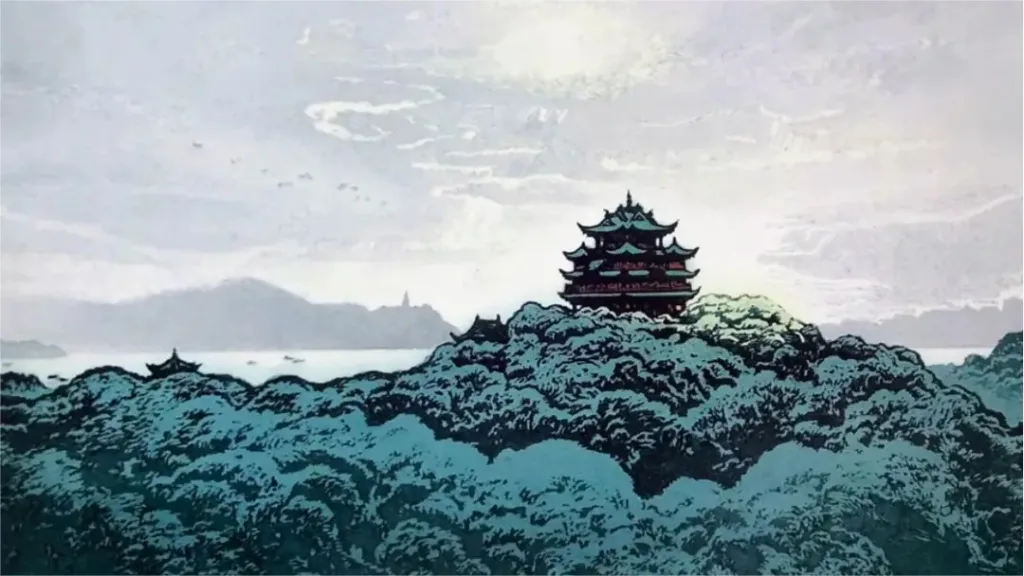The City God Pavilion, also known as Chenghuang Pavilion (城隍阁), situated atop Wu Mountain in Hangzhou, is a magnificent seven-story structure echoing architectural styles from the Southern Song and Yuan dynasties. Spanning an area of 3789 square meters and towering at 41.6 meters, it exudes grandeur and elegance, seamlessly blending elements from Yuan and Ming dynasty palace architecture. With a panoramic view, it captures the essence of Hangzhou’s rivers, mountains, lakes, and cityscape.
The pavilion showcases rich local history, culture, and folk customs on the first and second floors. The third and fifth floors house public tea rooms and host cultural performances, while the fourth floor offers the most stunning vantage point for scenic views. The sixth floor serves as an exclusive reception area for distinguished guests.
Historically, Wu Mountain was a bustling hub for leisure and entertainment, with markets bustling at its foot and incense markets atop the mountain. Throughout the year, people flocked to Hangzhou to pay respects, admire the tides, sightsee, indulge in entertainment, shop, and conduct business, all converging spontaneously at Wu Mountain, making it a vibrant and lively destination throughout the seasons.
Table of Contents
- Basic Information
- Location and Transportation
- Highlights of City God Pavilion
- Vlog about City God Pavilion
- Attractions near City God Pavilion
Basic Information
| Estimated Length of Tour | 1 hour |
| Ticket Price | 30 RMB |
| Opening Hours | 8.00 – 20.00 |
| Telephone Number | 0086-0571-87827973 |
Location and Transportation
The City God Pavilion is situated atop Wu Mountain at No. 3 Wushan Square in Shangcheng District, Hangzhou City. To get there, you can choose one of the following ways:
Bus: Take bus 8, 13, 39, 66, 71, 84, 195, 198, 283, 287, 308, 315, 352, 7280, 7295, 8230, 8514, or WE1314, get off at Gulou Stop (鼓楼站), and walk about 700 meters to the southwest to reach the pavilion.
Metro: The closest metro station to the City God Pavilion is Wushan Square on line 7. After getting out of the station from Exit C, walk about 500 meters to the south to reach the pavilion.
Highlights of City God Pavilion
Wu Mountain Scenery Relief

At the entrance of the scenic area stands a large granite relief titled “Wu Mountain Scenery.” This impressive artwork spans 27 meters in length and 6 meters in height. Set against the backdrop of the Southern Song Dynasty, with the City God Temple as its centerpiece, it vividly depicts the bustling and vibrant atmosphere of the ancient street during temple fairs held on Wu Mountain. The relief portrays a scene teeming with ancient-style teahouses, taverns, and local delicacies, alongside various entertainers such as musicians, storytellers, and fortune tellers. It offers a glimpse into the diverse array of activities and characters present during festive occasions, showcasing a rich tapestry of life in ancient Hangzhou.
Wooden Sculpture of Southern Song Hangzhou

Housed on the first floor of the City God Pavilion, the three-dimensional wooden sculpture titled “Southern Song Hangzhou” is considered a treasure of the pavilion. Spanning 31.5 meters in length, 3.65 meters in height, and 2 meters in depth, this artwork portrays the glorious era of the Southern Song Dynasty, a pinnacle in Hangzhou’s history. It meticulously recreates the imperial palaces, government offices, streets, bridges, shops, temples, and residences of the era, along with scenes depicting various aspects of daily life and cultural activities. With over 3,500 meticulously crafted figures dressed in period attire and more than 1,000 intricately detailed architectural structures, the sculpture provides a comprehensive panorama of life in ancient Hangzhou. From brewing wine to guarding the city walls, from lantern festivals to the serene beauty of West Lake, the sculpture captures the essence of Hangzhou’s rich history and cultural heritage, offering visitors a captivating journey back in time to the vibrant streets of ancient Hangzhou over 800 years ago.
Mud Sculpture Exhibition

The “Ou Sculpture,” originating from Wenzhou, Zhejiang Province, derives its name from the old name for Wenzhou, “Dong Ou,” and is also known as “oil mud sculpture.” The exhibition hall on the second floor of the City God Pavilion features 11 large-scale mud sculptures depicting historical events, figures, and stories related to Wu Mountain in Hangzhou. Scenes such as Sun Quan’s conquest of Taiwan, the grandeur of the Qiantang River, Emperor Qianlong’s suppression of local tyrants, and the legendary deeds of local heroes like Wen Riguang and Hu Xueyan are vividly brought to life through intricate mud sculptures.
Teahouse

The City God Pavilion, towering at the summit of Wu Mountain, has been a symbol of Hangzhou since its construction. The third and sixth floors are dedicated to teahouses, adorned with traditional Chinese furniture. The spacious platforms provide an excellent setting for moon gazing, tea appreciation, and leisurely moments. Visitors can enjoy performances of Jiangnan silk and bamboo music and professional tea ceremonies while savoring the finest teas. The teahouse has hosted numerous central leaders and domestic and foreign dignitaries, making it a unique feature of the pavilion.
City God Temple

Located within the City God Pavilion scenic area, the City God Temple enshrines the deity Zhou Xin, also known as Zhou Rixin, a righteous and upright official from Guangdong and Hainan provinces during the Ming Dynasty. Zhou Xin, appointed as a censor in the first year of the Yongle reign (1403) of the Ming Dynasty, was known for his integrity and fearlessness in combating corruption. The statue of Zhou Xin, measuring a total height of five meters, is accompanied by standing figures of military and civilian officials, each holding weapons and seals respectively, with a height of 3.8 meters each. The three statues are collectively adorned with 20 taels of gold leaf. The design of the Zhou Xin statue draws inspiration from the prototype of the City God Temple in Shanghai. At the top of the statue is a shrine, measuring 2.5 meters in length and 2.8 meters in width.








